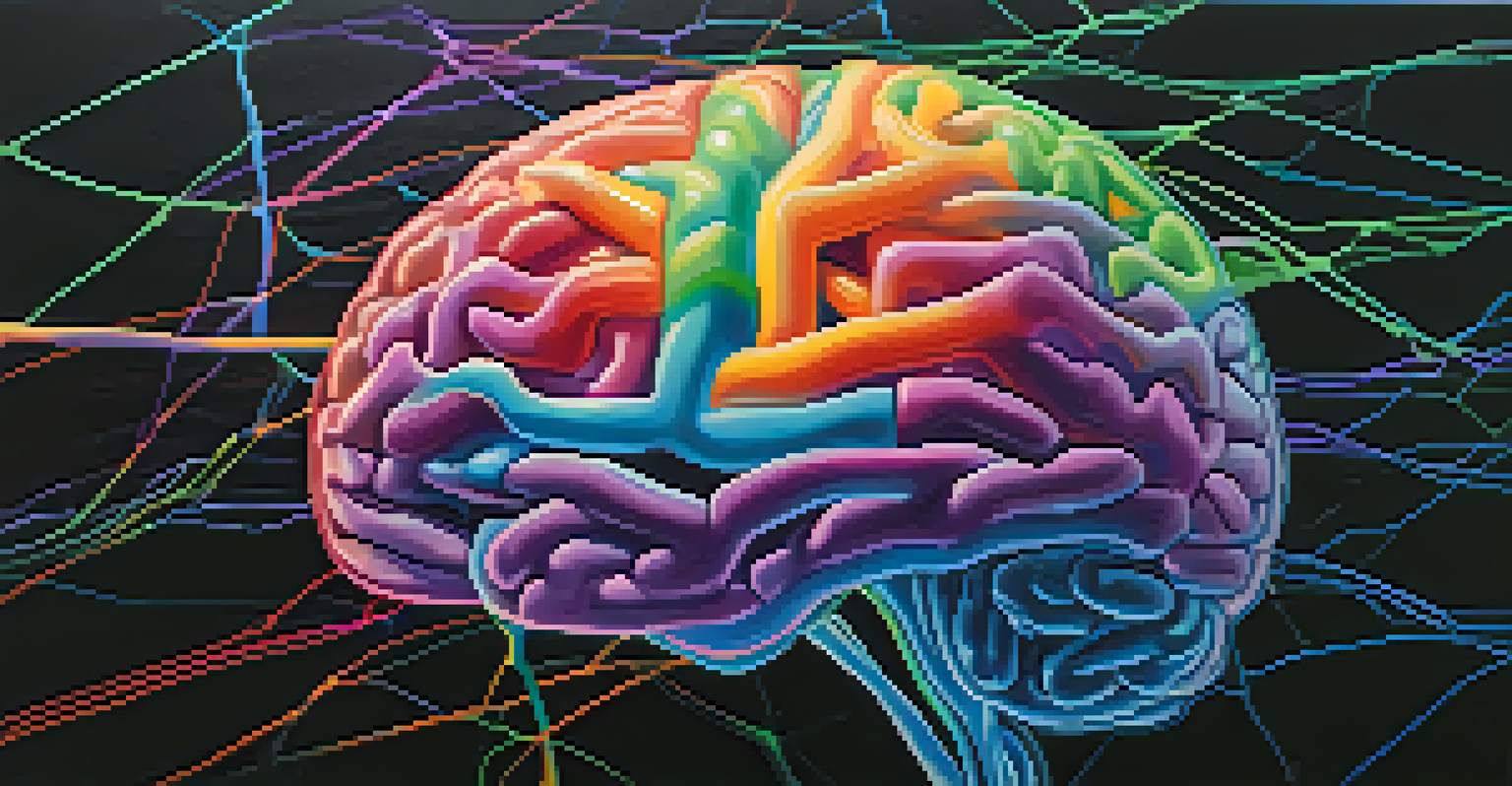The Science Behind Hallucinogens and Consciousness Alteration

Understanding Hallucinogens: What Are They?
Hallucinogens are a class of substances that significantly alter perception, mood, and various cognitive processes. Common examples include LSD, psilocybin (magic mushrooms), and mescaline. These compounds can create profound changes in sensory experiences, often leading to visuals or feelings not rooted in reality.
The use of hallucinogens can facilitate deep emotional healing and personal breakthroughs.
While many people associate hallucinogens with recreational use, they have also been studied for their potential therapeutic benefits, particularly in mental health. Researchers are examining how these substances affect the brain and whether they can help with conditions like PTSD or depression. Understanding the basics of what hallucinogens are sets the stage for deeper exploration into their effects.
The unique experiences induced by hallucinogens have intrigued humans for centuries, prompting both scientific inquiry and cultural rituals. From ancient traditions to modern therapy sessions, the fascination with altered states of consciousness continues to grow, beckoning a closer look at the science behind these powerful substances.
How Hallucinogens Interact with the Brain
Hallucinogens primarily affect the brain's serotonin receptors, particularly the 5-HT2A receptor. When these substances bind to these receptors, they can lead to altered perceptions and significant changes in mood. This interaction is a key reason why users experience vivid hallucinations and a sense of detachment from reality.

The brain's default mode network (DMN), which is responsible for self-referential thoughts and mind-wandering, also plays a crucial role in the experience of hallucinogens. Studies show that hallucinogens can reduce DMN activity, often leading to a feeling of interconnectedness between the individual and their surroundings. This reduction may explain the profound spiritual or mystical experiences many report.
Hallucinogens Alter Perception
Hallucinogens significantly change sensory experiences and mood by interacting with brain receptors.
Additionally, the overall brain connectivity is enhanced during hallucinogenic experiences, resulting in a more integrated perception of information. This increased connectivity can lead to new insights and perspectives, as the brain's usual filters are temporarily bypassed. Understanding these neural mechanisms helps to clarify why hallucinogens have such a powerful impact on consciousness.
The Role of Set and Setting in Hallucinogenic Experiences
The concept of 'set and setting' is crucial in understanding how hallucinogens affect individuals. 'Set' refers to the user's mindset, including their expectations and emotional state, while 'setting' pertains to the physical and social environment in which the substance is consumed. Together, these factors can shape the nature of the experience significantly.
Consciousness is a complex and often elusive topic that has fascinated scientists and philosophers alike.
For example, someone in a supportive, calm environment may have a positive and enlightening experience, while the same person in a chaotic or threatening setting might encounter fear or anxiety. This highlights the importance of creating a safe, controlled environment when exploring hallucinogens for therapeutic purposes. The ambiance can greatly influence the quality of the experience.
Research indicates that positive set and setting can enhance the therapeutic effects of hallucinogens, helping individuals confront and process difficult emotions or traumas. By fostering supportive conditions, therapists can optimize the healing potential of these substances. Thus, understanding the interplay of psychological and environmental factors is essential for anyone interested in the effects of hallucinogens.
Potential Therapeutic Applications of Hallucinogens
In recent years, there's been a resurgence of interest in the therapeutic potential of hallucinogens. Clinical trials have explored their benefits in treating various mental health conditions, such as anxiety, depression, and substance use disorders. The results have been promising, suggesting that these substances can facilitate deep emotional healing and personal breakthroughs.
One notable example is the use of psilocybin in treating treatment-resistant depression. Studies have shown that a single dose can lead to lasting improvements in mood by promoting neuroplasticity, the brain's ability to adapt and change. This suggests that hallucinogens might not just mask symptoms, but rather address underlying issues at a neurological level.
Therapeutic Uses Are Emerging
Research indicates hallucinogens may effectively treat mental health conditions like depression and PTSD.
However, it's crucial to approach this research with caution. While the findings are encouraging, more studies are needed to fully understand the long-term effects and best practices for using hallucinogens in therapeutic settings. As the stigma surrounding these substances fades, we may uncover more about their potential as treatment tools in mental health care.
The Science of Consciousness: What Is It?
Consciousness is a complex and often elusive topic that has fascinated scientists and philosophers alike. It encompasses our awareness of ourselves and our environment, allowing us to experience thoughts, emotions, and sensations. Despite extensive research, the exact nature of consciousness remains one of the greatest mysteries in science.
In the context of hallucinogens, consciousness can shift dramatically, leading to altered states that defy ordinary experience. These substances can provide insights into the workings of consciousness by temporarily disrupting typical thought patterns and perceptions. This disruption allows researchers to explore how consciousness operates in different states, shedding light on its fundamental nature.
Some scientists propose that studying altered states of consciousness through hallucinogens may help unlock secrets about human cognition and the brain's functioning. By understanding how these substances interact with consciousness, we can gain valuable insights into the mind and its capabilities, potentially informing fields beyond psychology, such as artificial intelligence and neuroscience.
Cultural Perspectives on Hallucinogens and Consciousness
Throughout history, various cultures have utilized hallucinogens for spiritual and healing purposes. Indigenous tribes often incorporate these substances into rituals to connect with the divine or gain insights into their lives. These cultural practices highlight a long-standing recognition of the potential benefits of altered states of consciousness.
For instance, ayahuasca, a brew made from Amazonian plants, is used by many South American tribes in shamanic ceremonies. Participants often report profound psychological and spiritual experiences, leading to personal revelations and healing. Such cultural contexts provide a rich tapestry of knowledge about the impact of hallucinogens on consciousness.
Cultural Practices Influence Use
Historical and cultural contexts showcase the long-standing recognition of hallucinogens for spiritual and healing benefits.
As modern society begins to re-evaluate the use of hallucinogens, there is an opportunity to learn from these traditional practices. By respecting and integrating cultural perspectives, contemporary research can develop more holistic approaches to studying and applying hallucinogens. This not only enriches our understanding but also honors the wisdom of those who have long recognized the power of these substances.
The Future of Hallucinogen Research and Consciousness Studies
As the stigma surrounding hallucinogens continues to dissipate, the future of research in this field looks promising. Emerging studies are beginning to uncover the potential benefits of these substances, both for individual healing and as tools for understanding consciousness. With increased funding and interest, we may soon see significant advancements in this area.
Researchers are exploring a variety of hallucinogens and their effects on mental health, cognition, and creativity. The potential for new therapies could transform how we approach mental health care, offering alternatives to traditional treatments. This shift could lead to a deeper understanding of the human mind and its complexities.

Moreover, as technology evolves, new methods for studying brain activity during hallucinogenic experiences are being developed. This could provide unprecedented insights into the nature of consciousness itself. As we move forward, the intersection of hallucinogen research and consciousness studies promises to be an exciting frontier in science.